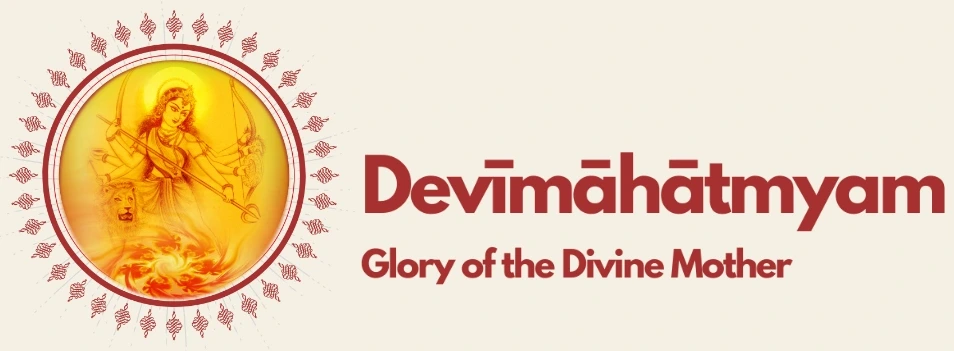Navākṣarī
‘Vāk became all these worlds’ vāgeva viśva bhūvanāni jajne, declares the Vedic Seer. The Tantra speaks of the Nāda Brahman as the creator of the worlds. The Tantrics hold that the Word or sound-creation precedes the creation of objects, sound first and sense next, arthaśrṣṭaḥ pūrvam śabdasṛṣṭiḥ. The Ṛṣi, the seer when he perceives the Truth, perceives at the same time the sound embodying the Truth. He receives it in the secret depths of his being and gives expression to it in the human tongue. This is the Mantra. When the Mantra is properly uttered, the sound - force from which it has sprung is contacted, which in turn reveals the Truth it embodies. So when the Mantra of a deity is uttered, the vibrations create the sound - body of the deity and with repeated utterances, the sound- body of the deity becomes concretely formed and the powerful Presence of the deity is established. Mantra is not merely a means to contact the Divine, as is popularly imagined; it is the Divine itself, it is its sound-form. So it is wrong to think of Mantra as a collection of letters. The Tantra declares: “To hell he goes who mistakes the Guru for a human, who takes the image for a piece of stone, who looks upon the Mantra as mere letters.”1
“The Mantra is an ever - living embodiment of the Truth and Power which have found expression in it through the medium of the Ṛṣi or Yogin who has given them that body. And when a Mantra is uttered, under proper conditions, it is not the feeble voice of the reciter that goes forth to evoke the response of the Gods to whom it is addressed but the flame of tapasyā and realisation, that is lying coiled up in the body of that utterance.“2
1. देशिके मानवभ्रान्तिं प्रतिमास्तु शिलामतिम्।
मन्त्रेष्वक्षरवुद्धिं च कुर्वाणो निरयं व्रजेत्॥
2. Further Lights: The Veda and the Tantra by Sri Kapali Sastriar.
And the living touch of the Guru is needed to set the Mantra awake in the disciple. When the Guru initiates the disciple into the Mantra, he implants the Mantra along with his realisation of the Mantra and the living presence of the deity invoked. The disciple has only to tend and nurture the consciousness put into him by the Guru. The seed sown into him by the Guru will germinate, put forth shoots, blossom and yield fruits at the appropriate time. Where the Guru is a powerful personality, a great Mantra Siddha, the word of the Mantra emanating from him at the time of initiation will itself carry out the Sādhanā, by constantly reverberating of its own accord in the heart of the disciple. The disciple on his part has always to relive the experience of the initiation.1
The nine lettered Navārṇa Mantra is the sound body of Chaṇḍikā composed of the nine Durgās.2 The Devī atharvaśīrṣa upaniṣad proclaims this Mantra and extols it as Mahadānanda dāyakaḥ, giver of the highest Delight. “Brahmasāyujya pradaḥ” says Sri Bhaskararaya, interpreting this phrase. The Mantra grants to the Sādhaka union with the Brahman that is pure Delight, Ānanda.
1. There is a striking desription of the action of Mantra in Sri Aurobindo’s epic Savitri (IV.3):
“As when the mantra sinks in Yoga’s ear,
Its message enters stirring the blind brain
And keeps in the dim ignorant cells its sound;
The hearer understands a form of words
And, musing on the index thought it holds,
He strives to read it with the labouring mind,
But finds bright hints, not the embodied truth:
Then, falling silent in himself to know
He meets the deeper listening of his soul:
The Word repeats itself in rhythmic strains:
Thought, vision, feeling, sense, the body’s self
Are seized unalterably and he endures
An ecstasy and an immortal change;
He feels a Wideness and becomes a Power,
All knowledge rushes on him like a sea:
Transmuted by the white spiritual ray
He walks in naked heavens of joy and calm,
Sees the God-face and hears transcendent speech.”
2. There is a close correlation between the form of the deity as conceived in Dhyāna and the form of the Mantra, as the Mantra is its sound-body. For example, the Mantra of Śiva, the five-faced is the five-lettered Pañcākṣarī, that of Subrahmaṇya, the six-faced is the six-lettered sarvavanabhāva Mantra. The twelve manifestations of Vāsudeva-Keśhava, Nārayāṇa, Mādhava, Govinda, Viṣṇu, Madhūsudana, Trivikrama, Vāmana, Śrīdhara, Hṛṣikeśa, Padmanābha, Dāmodara- are represented by the twelve lettered dvādaśākṣarī. In the Lallita cult, it is explicitly stated that the body of Tripurasundarī is made of the three Kuṭas of the Mantra, Mūlakuṭatraya halevara.
“Aiṁ Hrīṁ Klīṁ Cāmuṇḍayai Vicce” is the Mantra. If all the vowels and consonants in the Mantra are counted, it will be twenty-four and so some acclaim this as the Gāyatrī of Caṇḍī. Actually there is a sevenfold division in the Mantra Aiṁ Hrīṁ Klīṁ Cāmuṇḍayai Vit ca e. Cāmuṇḍayai is in the dative case while the six others are in the vocative case Aiṁ is the Vakbija, the seed - sound of Mahāsaraswatī, knowledge that is consciousness, Cit and corresponds to Vit in the lower triple. Hrīṁ is the Māyābija, the seed - sound of Mahālakṣmī, the all - pervasive existence Sat and corresponds to Ca in the lower triple. Klīṁ is kāmābija, the seed sound of Mahākalī, all the consuming delight, Ānanda, and corresponds to e in the lower triple. Mahāsarasvatī, Mahālakṣmī and Māhākalī represent the higher triple state of the God-head, Cit, Sat and Ānanda in the other half parārdha and they get involved in creation, in the lower Triple worlds. trailokyam, physical, vital and mental, anna, prāṇa and manas through Vijñāna. Gnosis represented by Cāmuṇḍa. And the lower triple in turn has to evolve into the higher triple through Cāmuṇḍa. Thus in the Mantra, Aiṁ Hrīṁ Klīṁ and Vicce represent the higher triple and the lower triple worlds respectively , while Cāmuṇḍayai denotes the world of Vijñāna, Gnosis, the plane of light, Mahas. The Mantra is an invocation to the supreme goddess in the form of Truth - Consciousness - Bliss, made by the being circumscribed by the lower triple of physical vital and mental states. The prayer is made so that the being is freed by the grace of Cāmuṇḍa from his present triple state of distortion to reach the true state of Truth - Consciousness - Bliss. Each letter in the Mantra has to be contemplated in a definite colour.1 The Tantra says that the first seed - sound Aiṁ has a moonlike lustre, the second seed - sound Hrīṁ has the effulgence of the sun and the third seed - sound which has to be contemplated for endless delight, Klīṁ blazes like the fire. The letter Ca has the shining of pure gold and mun is deep red in colour; ḍa is deep blue dispelling the worst distress while yai is all black destroying the foes. Vi, the eighth letter has the primary white colour and cce the ninth has a vast sweep of smoky hue.2
The Navārṇa Mantra is always done as a limb of Saptaśati and rarely by itself.
1. The word for letter Varṇa alos means colour. It is said that Mantras have their own spectrums and they are perceived in inner contemplation of the Mantra.
2. ऐं बीजमादीन्दुसमानदीप्तिं ह्रीं सूर्यतेजोद्युतिमद् द्वितीयम्।
क्लीं मूर्तिवैश्वानरतुल्यरूपं तृतीयमानन्त्यसुखाय चित्यम्॥
चां शुद्धजाम्बूनन्दकान्ति तुर्यं मुं पञ्चमं रक्ततरं प्रकल्प्य।
डां षट्कमुग्रार्तिहरं सुनीलं यै सप्तमं कृन्वतरं रिपुघ्नम्॥
विं पाण्डरं चाष्टममादिसिद्धं च्चें धूम्रवर्णं नवं विशालं॥

